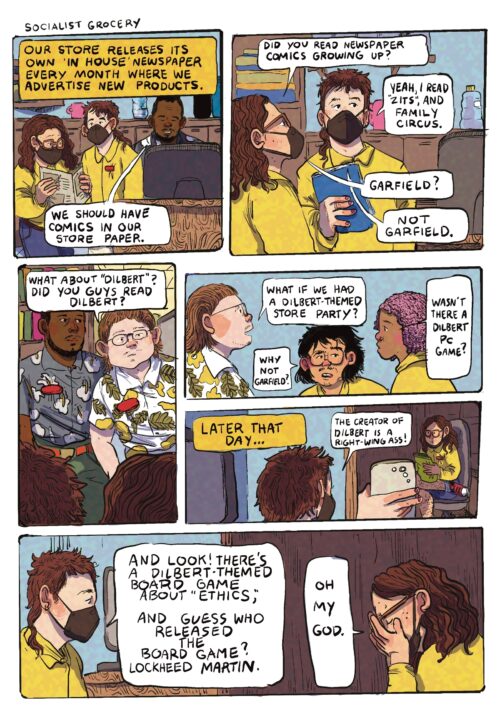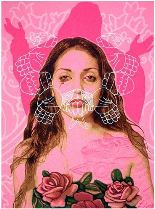
“Visiones from Postmodern Aztlan” at Taller Puertorriqueno is an exhibit chock-a-block with prints made in a print studio in Texas and a print studio in Los Angeles, both of which specialize in Chicano art. It also features some pieces from four local artists with Mexican backgrounds.
Now I didn’t realize that Chicano, by definition, meant political, as in Mexican self-definition and protest north of the border. But I was lucky and bumped into Anabelle Rodriguez, the show’s curator, while I was at Taller looking, and she explained.
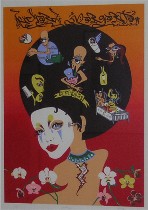 For the most part this is not the kind of political art that descends into didactic modes, telling you what to think. It’s art about identity and culture and mythologies and the border where cultures meet. So the imagery is a rich mix of Mexican, and American–especially pop culture–and traditional painterly and print-making modes of expression.
For the most part this is not the kind of political art that descends into didactic modes, telling you what to think. It’s art about identity and culture and mythologies and the border where cultures meet. So the imagery is a rich mix of Mexican, and American–especially pop culture–and traditional painterly and print-making modes of expression.
And it’s about yearning for Aztlan, which Rodriguez said was a kind of mythical land, and in the case of Mexicans who came north, a place that they created in their minds and yearned for.
There’s much to love and much to delve into in this show.
I suppose the easiest way to start is via the studios. The Texas work is more painterly, more art-traditional, which is not to say it’s dull. It’s just different from the L.A. work which is more pop-influenced graphical.
The two images above are from L.A., with Alma Lopez’s “La Llorona Desperately Seeking Coyolxauhqui” (top) using the Mexican taste for decoration that makes me think of the Los Angeles house of a Mexican friend of mine, a tiny space lovingly filled with crochet work, flowers and lace. The image is mixed with tears, yearning for a mental space that mixes the myths of the distant past and the more recent Mexican Catholicism, stirring it up with a thoroughly modern, pop, pink young woman. Favianna Rodriguez’s “Margarita,” (above, right) sporting a white-face mask, is teeming with pop cartoon imagery that includes Mexican gods from the past and images of a sick person getting cured straight from Mexican art and shaman traditions.
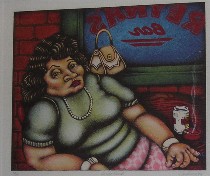 The Texas prints come from Coronado Studio in Austin, Texas. Studio founder Sam Coronado was inspired by the work of the Los Angeles print studio Self-Help Graphics & Art, which has been specializing in and encouraging Chicano voices through art for 30 years, and which is the source for the other suite of prints in the show (left, Celina Hinojosa’s “Andaba Perdida” from Coronado shows a tough babe with body like a landscape in a claustrophobic space).
The Texas prints come from Coronado Studio in Austin, Texas. Studio founder Sam Coronado was inspired by the work of the Los Angeles print studio Self-Help Graphics & Art, which has been specializing in and encouraging Chicano voices through art for 30 years, and which is the source for the other suite of prints in the show (left, Celina Hinojosa’s “Andaba Perdida” from Coronado shows a tough babe with body like a landscape in a claustrophobic space).
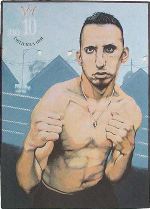 Using the most popular technique for political posters–the silkscreen print–both groups of artists have created varied imagery with varied affect, but what was chosen largely expresses that yearning for Aztlan and expresses the confusion, anger, and difficulty of mixing the Mexican with the American .
Using the most popular technique for political posters–the silkscreen print–both groups of artists have created varied imagery with varied affect, but what was chosen largely expresses that yearning for Aztlan and expresses the confusion, anger, and difficulty of mixing the Mexican with the American .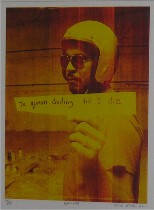 The images show the range of emotions from dark, like like Vincent Valdez’s “No. 10 – Collector’s Item” (right, above) or his “Suspect: Dark Clothes, Dark Hair, Dark Eyes, Dark Skin,” images of outsiders making their way in a strange land. One of my favorites was Cruz Ortiz‘s “Darling,” (left), which captures the stripy-ness of a bad computer print-out, the tender note as ragged as the scenery and the print quality, and the helmeted lover so serious, forlorn and so ordinary and down-at-the-heels looking. It’s not clear if the darling is his wife (he’s got a wedding ring on) or Mexico.
The images show the range of emotions from dark, like like Vincent Valdez’s “No. 10 – Collector’s Item” (right, above) or his “Suspect: Dark Clothes, Dark Hair, Dark Eyes, Dark Skin,” images of outsiders making their way in a strange land. One of my favorites was Cruz Ortiz‘s “Darling,” (left), which captures the stripy-ness of a bad computer print-out, the tender note as ragged as the scenery and the print quality, and the helmeted lover so serious, forlorn and so ordinary and down-at-the-heels looking. It’s not clear if the darling is his wife (he’s got a wedding ring on) or Mexico.
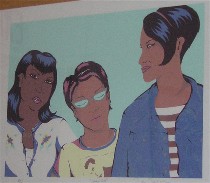 One of the surprises about this show was the large number of women showing. Shizu Saldamando’s “Snapshot” (right) is a portrait of assimilation, showing herself (she’s the one on the left) with two buddies, the middle one wearing a Morrissey t-shirt (as opposed to a Los Lobos t-shirt or some such). [Correction 8/7/04: I just got a note from Shizu saying the gal on the left is not a self-portrait. Silly me and silly Anabelle. We thought it was because she was wearing a necklace that said Shizu. You’ll have to put the rest together for yourself.]
One of the surprises about this show was the large number of women showing. Shizu Saldamando’s “Snapshot” (right) is a portrait of assimilation, showing herself (she’s the one on the left) with two buddies, the middle one wearing a Morrissey t-shirt (as opposed to a Los Lobos t-shirt or some such). [Correction 8/7/04: I just got a note from Shizu saying the gal on the left is not a self-portrait. Silly me and silly Anabelle. We thought it was because she was wearing a necklace that said Shizu. You’ll have to put the rest together for yourself.]
There were many more prints worth the trip north of the Market Street border to Taller.
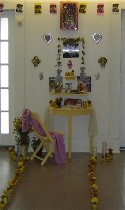 And speaking of borders, local artist Marta Sanchez included an altar in tribute to Gloria Anzaldu, who wrote the much acclaimed “Borderlands/La Frontera” and was a lesbian and Mexican activist. She died several weeks ago. Sanchez, who organizes the annual Cascarones fundraiser for children with AIDS, is also a printmaker, and the altar includes lots of little linoleum block prints. It’s also a reminder of how Mexican culture persists even in Philadelphia.
And speaking of borders, local artist Marta Sanchez included an altar in tribute to Gloria Anzaldu, who wrote the much acclaimed “Borderlands/La Frontera” and was a lesbian and Mexican activist. She died several weeks ago. Sanchez, who organizes the annual Cascarones fundraiser for children with AIDS, is also a printmaker, and the altar includes lots of little linoleum block prints. It’s also a reminder of how Mexican culture persists even in Philadelphia.
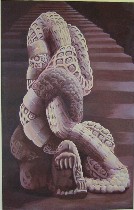 Cesar Viveros, a Philadelphia muralist who works on his own and with Meg Saligman, showed some enormous paintings that reimagined Mexican mythic symbols for a modern world, including a painting of a Mexican-influenced pieta mixed up with broken idols (right, “Quetzcoatl,” the god whose myth was twisted by Montezuma, who came to believe Cortez and Christianity were Quetzcoatl’s heir). These powerful grisaille paintings restore a heroic stature to the old stories and myths.
Cesar Viveros, a Philadelphia muralist who works on his own and with Meg Saligman, showed some enormous paintings that reimagined Mexican mythic symbols for a modern world, including a painting of a Mexican-influenced pieta mixed up with broken idols (right, “Quetzcoatl,” the god whose myth was twisted by Montezuma, who came to believe Cortez and Christianity were Quetzcoatl’s heir). These powerful grisaille paintings restore a heroic stature to the old stories and myths.
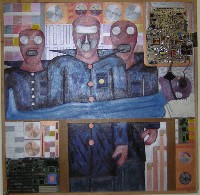 Also from the local scene were Brujo de la Mancha’s bold acrylics and a mixed-media painting( right, “Diagnastico” ). This work reflects traditional Mexican paintings and tableaux calling for a miracle cure. But in this case, the cure must be worse than the illness, the poor sick fellow attached to various real-world computer chips and electronica. I loved the ceremonial arrangement of the so-called doctors standing over the supine body. I also loved the equation of technology to milagros.
Also from the local scene were Brujo de la Mancha’s bold acrylics and a mixed-media painting( right, “Diagnastico” ). This work reflects traditional Mexican paintings and tableaux calling for a miracle cure. But in this case, the cure must be worse than the illness, the poor sick fellow attached to various real-world computer chips and electronica. I loved the ceremonial arrangement of the so-called doctors standing over the supine body. I also loved the equation of technology to milagros.
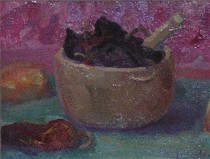 Also shown were some small pieces of traditional Mexican subjects like this still life of chiles (left) from Rocio Levito, who returned to Mexico several weeks ago to attend art school.
Also shown were some small pieces of traditional Mexican subjects like this still life of chiles (left) from Rocio Levito, who returned to Mexico several weeks ago to attend art school.






